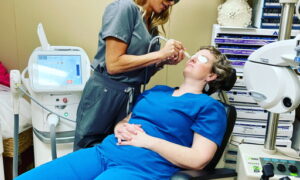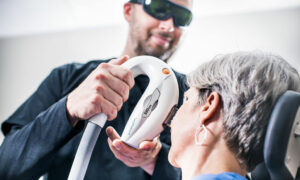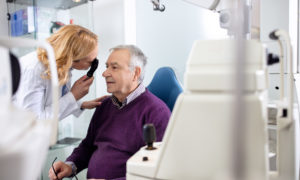By Mark Schaeffer, OD

Jan. 9, 2018
Diabetes is a significant health-care challenge. According to the Centers for Disease Control, 30.4 million Americans have diabetes, and one-in-four of them don’t know they have it.
In my practice, care of diabetic patients has become a key focus. We continue to see an influx of diabetic patients into our clinic. We have developed a great network for the community to refer into, and get results back from the office in a timely manner.
Our growth rate of these patients continues to rise as the disease is becoming more prevalent. As insurance providers tie reimbursement to photos and testing from the primary-care physician, there is increased referral into our offices, as well. That growth is hard to quantify, but our letters to primary-care doctors (PCPs) on behalf of diabetic patients have increased from 1-2 per day to 3-5 per day per doctor in the practice.
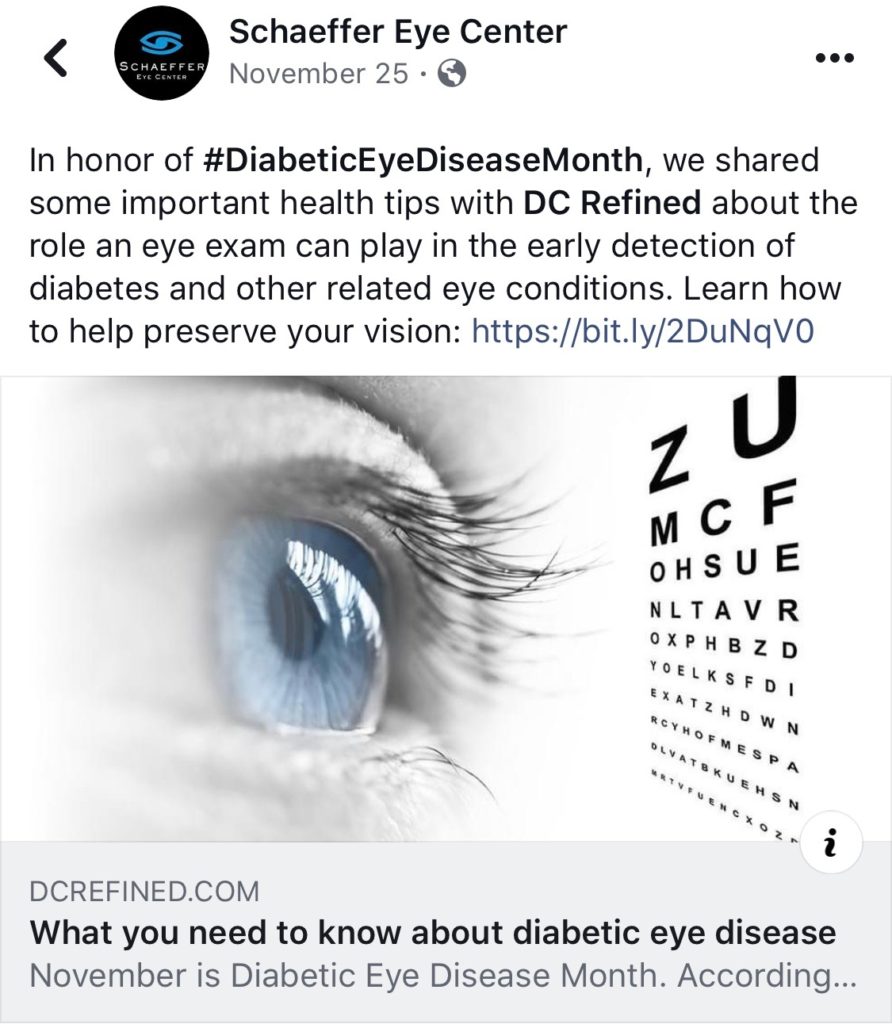
A social media post from Schaeffer Eye Center promoting the diabetic eyecare services the practice provides. Dr. Schaeffer says marketing to patients on social media is a good way to let those with diabetes know you’re there to help.
The revenue from our diabetic patients vary based on severity and follow-up. Most of our diabetic patients have a visual field and retinal photo done on an annual basis to detect progression or disease state.
Editors’ Note: Be sure to pull the LCD (if no LCD exists, then the NCD) for each test to understand reimbursement rules and document changes from previous tests to make sure an auditor will approve reimbursement. NCD = National Carrier Determination, LCD = Local Carrier Determination, LCDs trump NCDs.
The more severe the retinopathy, the more follow-up visits and medical testing the patient will need. A patient with the highest level of monitoring without a referral to an ophthalmologist for laser, or injections, would be 3-4 visits per year with retinal photos, retinal imaging (OCT), and visual fields to monitor for progression and changes.
Editors’ Note: Be sure to pull the LCD (Local Carrier Determination) for each test to understand what the reimbursement limits are for number of tests per year and what is necessary to do for reimbursement if you exceed the limits.

Dr. Schaeffer speaking to a group of senior citizens in his community about eye health, including diabetic eyecare. He says that speaking to seniors in the community is a great way to help people take better care of their eyes, and to help grow a practice.
Encourage & Generate Referrals from Primary-Care Doctors
Most of our diabetic patients are the patients we typically see on an annual basis. These patients are living out there, needing eyecare, and come to our office because of our medical reputation. We also get referrals from area physicians, who need testing and an eye examination done for patients in our area.
It all starts with referral letters. We take pride in getting out our referral letters in a timely manner so that primary-care physicians know that when they come to see us, they’ll get communication back quickly. As a primary-care eye provider, all of our doctors can remember diagnosing someone with diabetes prior to their PCP doing so. When we have those patients, we have a network of doctors’ offices where we can send them. Those physicians then know that we are actively looking for, and managing, diabetic eye disease.
Standardize Reports to PCPs
We have a standardized report to highlight the most important information for PCPs to have: visual acuities, presence of diabetic retinopathy, degree of retinopathy and follow-up protocol. The reports were streamlined to take the doctor less than two minutes to fill out. The letter is then faxed to the office by the staff. Our EHR also has a template for reports to be sent via fax without filling out any forms.
Editor’s Note: Click HERE for the American Optometric Association’s Diabetes Report, which also can help guide your communication with PCPs on diabetic patient care.
Other Articles to Explore
Invest in Key Instrumentation
The instrumentation that is important in diagnosing and managing diabetic eye disease is a retinal camera (that may have fundus autoflourescence capabilities), visual field (FDT or SITA) and OCT. These devices are used for many other conditions, and come in a range of prices, from $15,000 to over $100,000 depending on the features of the instrument. We are starting to see the importance of OCT-Angiography in diabetes now that this feature is becoming more commercially available across all devices (Zeiss, OptoVue and Heidelberg).
Create a Questionnaire for Staff to Use With Diabetic Patients
The staff has a simple questionnaire that should be administered to every diabetic patient who comes into our office. It asks the patient questions regarding their blood sugar markers and Hemoglobin A1c to assess disease state, the PCP doctor they see, so we can establish communication, how often they see their doctor, and their medications, to assess if there have been any changes in their care which would impact the condition of their eyes and vision (see the AOA Diabetic Report for examples). Our practice provides this training on-the-job, and we have technician training to do a broader overview of diabetes and its effects on the eye.
Do Community Outreach on Impact of Diabetes on Eyes
We have done outreach in the community to give presentations on the importance of diabetic eyecare to senior homes, assisted-living facilities, and we have even gone to health fairs to advocate for diabetic eye exams.
In addition, we have an active social media account that highlights the importance of diabetic care, especially during National Diabetes Month in November.
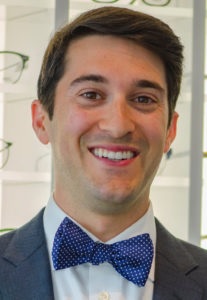 Mark Schaeffer, OD, is an optometrist at Schaeffer Eye Center, a 16-location practice in Alabama, founded by his father, Jack Schaeffer, OD. The practice recently was acquired by MyEyeDr. To contact him: mark.schaeffer@myeyedr.com
Mark Schaeffer, OD, is an optometrist at Schaeffer Eye Center, a 16-location practice in Alabama, founded by his father, Jack Schaeffer, OD. The practice recently was acquired by MyEyeDr. To contact him: mark.schaeffer@myeyedr.com

